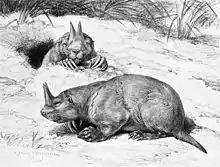This list is of rodent species that are extinct − no longer alive.
Species from related groups such as Lagomorpha (rabbits and hares) are not included.
Before 1500
| Genus | Species | Notes | Location | Approx. max. weight | Stratigraphy | Image |
|---|---|---|---|---|---|---|
| Castor | C. californicus | An extinct beaver species | Western North America | Late Miocene to Early Pleistocene[1] | ||
| Castoroides | Giant beavers | North America | Up to 100 kg (220 lb) | Pleistocene[1] |  | |
| Ceratogaulus | Horned gophers | North America | Smallest horned mammal | Late Miocene to Pliocene[2] |  | |
| Spelaeomys | S. florensis | A large cave rat | Flores | - | Extinct by 1500[3] | |
| "Giant hutias" | A paraphyletic group of rodents resembling large guinea pigs | West Indies | Up to 200 kg (440 lb) | Pleistocene[4] | ||
| Leithia | A giant dormouse | Europe (Malta, Sicily) | 113 g (4.0 oz) | Pleistocene[5] | ||
| Neochoerus | N. pinckneyi | A large capybara | North America | 100 kg (220 lb) | Pleistocene[6] | |
| Josephoartigasia | J. monesi | 'Giant pacarana', largest known rodent | South America | 1,500 kg (3,300 lb) | Pliocene to Early Pleistocene[7] |  |
| Phoberomys | P. pattersoni | A horse-sized rodent[8] | North America | Probably under 280 kg (620 lb);[8] earlier estimates up to 700 kg (1,500 lb)[9] | Miocene[8] | |
| Telicomys | A giant rodent, to 2 metres (6 ft 7 in) long | South America | Perhaps 70% of size of P. pattersoni[8] | Late Miocene to Early Pleistocene[8] |
Extinct after 1500
16th century
17th century
See also
- Extinct rodents – all periods
- Prehistoric rodents
- Rodent extinctions since 1500
References
- 1 2 Harington, C. R. (March 1996). "Giant beaver". Yukon Beringia Interpretive Centre. Archived from the original on September 14, 2007. Retrieved 3 July 2014.
- ↑ Hopkins, Samantha S. B. (2005). "The evolution of fossoriality and the adaptive role of horns in the Mylagaulidae (Mammalia: Rodentia)". Proceedings of the Royal Society B. 272 (1573): 1705–1713. doi:10.1098/rspb.2005.3171. PMC 1559849. PMID 16087426.
- ↑ Hooijer, D. A. (1957). "Three new giant prehistoric rats from Flores Lesser Sunda Islands". Zoologische Mededelingen. Rijksmuseum van Natuurlijke Historie, Leiden. 35 (21): 299–316.
- ↑ Biknevicius, A. R.; McFarlane, Donald A.; MacPhee, R. D. E. (1993). "Body size in Amblyrhiza inundata (Rodentia: Caviomorpha), an extinct megafaunal rodent from the Anguilla Bank, West Indies: estimates and implications" (PDF). American Museum Novitates (3079): 1–26.
- ↑ Petronio, C. (1970). "I roditori Pleistocenici della Grotta di Spinagallo (Siracusa)" (PDF). Geol. Rom. IX: 149–194. (in Italian)
- ↑ Kurtén, Björn; Anderson, Elaine (1980). Pleistocene Mammals of North America. Columbia University Press. p. 274. ISBN 0-231-03733-3.
- ↑ Rinderknecht, Andrés; Blanco, R. Ernesto (2008). "The largest fossil rodent". Proceedings of the Royal Society B. 275 (1637): 923–928. doi:10.1098/rspb.2007.1645. PMC 2599941. PMID 18198140.
- 1 2 3 4 5 Millien, Virginie; Bovy, Helene (2010). "When teeth and bones disagree: Body mass estimation of a giant extinct rodent". Journal of Mammalogy. 91 (1): 11–18. doi:10.1644/08-mamm-a-347r1.1. JSTOR 27755167.
- ↑ Sánchez-Villagra, M. R.; Aguilera, O.; Horovitz, I. (2003). "The anatomy of the world's largest rodent". Science. 301 (5640): 1708–10. doi:10.1126/science.1089332. PMID 14500978.
This article is issued from Wikipedia. The text is licensed under Creative Commons - Attribution - Sharealike. Additional terms may apply for the media files.